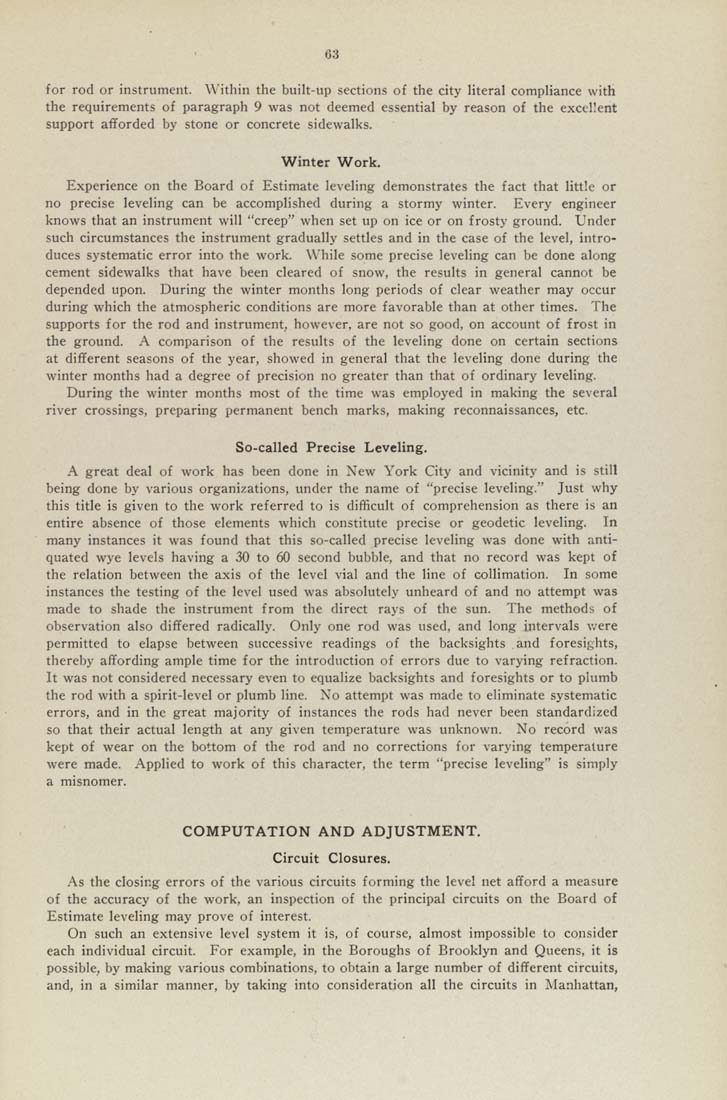for rod or instrument. Within the built-up sections of the city literal compliance with
the requirements of paragraph 9 was not deemed essential by reason of the excellent
support afforded by stone or concrete sidewalks.
Winter Work.
Experience on the Board of Estimate leveling demonstrates the fact that little or
no precise leveling can be accomplished during a stormy winter. Every engineer
knows that an instrument will "creep" when set up on ice or on frosty ground. Under
such circumstances the instrument gradually settles and in the case of the level, intro¬
duces systematic error into the work. While some precise leveling can be done along
cement sidewalks that have been cleared of snow, the results in general cannot be
depended upon. During the winter months long periods of clear weather may occur
during which the atmospheric conditions are more favorable than at other times. The
supports for the rod and instrument, however, are not so good, on account of frost in
the ground. A comparison of the results of the leveling done on certain sections
at different seasons of the year, showed in general that the leveling done during the
winter months had a degree of precision no greater than that of ordinary leveling.
During the winter months most of the time was employed in making the several
river crossings, preparing permanent bench marks, making reconnaissances, etc.
So-called Precise Leveling,
A great deal of work has been done in New York City and vicinity and is still
being done by various organizations, under the name of "precise leveling." Just why
this title is given to the work referred to is difficult of comprehension as there is an
entire absence of those elements which constitute precise or geodetic leveling. In
many instances it was found that this so-called precise leveling was done with anti¬
quated wye levels having a 30 to 60 second bubble, and that no record was kept of
the relation between the axis of the level vial and the line of collimation. In some
instances the testing of the level used was absolutely unheard of and no attempt was
made to shade the instrument from the direct rays of the sun. The methods of
observation also differed radically. Only one rod was used, and long intervals vjere
permitted to elapse between successive readings of the backsights and foresights,
thereby affording ample time for the introduction of errors due to varying refraction.
It was not considered necessary even to equalize backsights and foresights or to plumb
the rod with a spirit-level or plumb line. No attempt was made to eliminate systematic
errors, and in the great majority of instances the rods had never been standardized
so that their actual length at any given temperature was unknown. No record was
kept of wear on the bottom of the rod and no corrections for varying temperature
were made. Applied to work of this character, the term "precise leveling" is simjily
COMPUTATION AND ADJUSTMENT.
Circuit Closures.
As the closing errors of the various circuits forming the level net afford a measure
of the accuracy of the work, an inspection of the principal circuits on the Board of
Estimate leveling may prove of interest.
On such an extensive level system it is, of course, almost impossible to consider
each individual circuit. For example, in the Boroughs of Brooklyn and Queens, it is
possible, by making various combinations, to obtain a large number of different circuits,
and, in a similar manner, by taking into consideration all the circuits in Manhattan,
|








